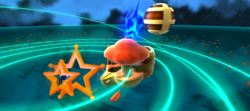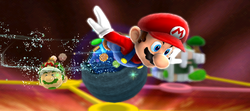Galaxy
A galaxy is a system consisting of gases, stars, planets, and comets. Mario or Luigi visit many galaxies in their adventures through Super Mario Galaxy and Super Mario Galaxy 2. There are currently a total of 91 different galaxies between the two games.
Most of the galaxies in Super Mario Galaxy are notably much smaller than real galaxies, often being composed of nothing more than a few small planetoids, most of which come in many different shapes and sizes. In World 4 however, a galaxy proportionate to a real galaxy appears in the background, while in World 5, there is a galaxy supercluster. Smaller galaxies in the games are more comparable to systems such as the Solar System. There are solar systems that can be seen to make up other galaxies that determine whether it is a large or small one.
In Super Mario Galaxy, there is clearly a size difference between galaxies. Some of them contain six or seven Power Stars, while others possess only one (two in the Buoy Base Galaxy and the Gateway Galaxy). The "main" galaxies with six to seven Power Stars are usually much larger than the "bonus" galaxies with one Power Star, which may contain only one or two planetoids. In Super Mario Galaxy 2, however, this difference isn't as prevalent, as each galaxy contains either two or three regular Power Stars.
In Super Mario Galaxy, most galaxies are located within six different domes onboard the Comet Observatory. These domes show the player up to five galaxies and give them the option to fly to those galaxies in order to search for Power Stars. Just outside of each dome is a Hungry Luma, which transforms into an additional galaxy after the player feeds it a certain number of Star Bits. The remaining galaxies in the game are accessed via other areas on or around the Comet Observatory, including the Planet of Trials and the Gate. In Super Mario Galaxy 2, galaxies are grouped into seven different Worlds, each of which contains a total of seven galaxies. One Hungry Luma is encountered in each World, which transforms into a new galaxy when called to Starship Mario and fed the required amount of Star Bits.
Many galaxies in both games contain Black Holes, which Mario and Luigi run the risk of getting sucked into if they fall off the edge of some planets or areas.
Super Mario Galaxy
Gate
- Gateway Galaxy
- Boo's Boneyard Galaxy (Hungry Luma)
Terrace
- Good Egg Galaxy
- Honeyhive Galaxy
- Loopdeeloop Galaxy
- Flipswitch Galaxy
- Bowser Jr.'s Robot Reactor
- Sweet Sweet Galaxy (Hungry Luma)
Fountain
- Space Junk Galaxy
- Rolling Green Galaxy
- Battlerock Galaxy
- Hurry-Scurry Galaxy
- Bowser's Star Reactor
- Sling Pod Galaxy (Hungry Luma)
Kitchen
- Beach Bowl Galaxy
- Bubble Breeze Galaxy
- Ghostly Galaxy
- Buoy Base Galaxy
- Bowser Jr.'s Airship Armada
- Drip Drop Galaxy (Hungry Luma)
Bedroom
- Gusty Garden Galaxy
- Freezeflame Galaxy
- Dusty Dune Galaxy
- Honeyclimb Galaxy
- Bowser's Dark Matter Plant
- Bigmouth Galaxy (Hungry Luma)
Engine Room
- Gold Leaf Galaxy
- Sea Slide Galaxy
- Toy Time Galaxy
- Bonefin Galaxy
- Bowser Jr.'s Lava Reactor
- Sand Spiral Galaxy (Hungry Luma)
Garden
- Deep Dark Galaxy
- Dreadnought Galaxy
- Matter Splatter Galaxy
- Melty Molten Galaxy
- Snow Cap Galaxy (Hungry Luma)
Planet of Trials
The Center of the Universe
Super Mario Galaxy 2
World 1
- Sky Station Galaxy
- Yoshi Star Galaxy
- Spin-Dig Galaxy
- Fluffy Bluff Galaxy
- Flip-Swap Galaxy (Hungry Luma)
- Rightside Down Galaxy
- Bowser Jr.'s Fiery Flotilla
World 2
- Puzzle Plank Galaxy
- Hightail Falls Galaxy
- Boulder Bowl Galaxy
- Cosmic Cove Galaxy
- Wild Glide Galaxy
- Honeybloom Galaxy (Hungry Luma)
- Bowser's Lava Lair
World 3
- Tall Trunk Galaxy
- Cloudy Court Galaxy
- Haunty Halls Galaxy
- Freezy Flake Galaxy
- Rolling Masterpiece Galaxy
- Beat Block Galaxy (Hungry Luma)
- Bowser Jr.'s Fearsome Fleet
World 4
- Supermassive Galaxy
- Flipsville Galaxy
- Starshine Beach Galaxy
- Chompworks Galaxy
- Sweet Mystery Galaxy (Hungry Luma)
- Honeyhop Galaxy
- Bowser's Gravity Gauntlet
World 5
- Space Storm Galaxy
- Slipsand Galaxy
- Shiverburn Galaxy
- Boo Moon Galaxy
- Upside Dizzy Galaxy
- Fleet Glide Galaxy (Hungry Luma)
- Bowser Jr.'s Boom Bunker
World 6
- Melty Monster Galaxy
- Clockwork Ruins Galaxy
- Throwback Galaxy
- Battle Belt Galaxy
- Flash Black Galaxy (Hungry Luma)
- Slimy Spring Galaxy
- Bowser's Galaxy Generator
World S
- Mario Squared Galaxy
- Rolling Coaster Galaxy
- Twisty Trials Galaxy
- Stone Cyclone Galaxy
- Boss Blitz Galaxy
- Flip-Out Galaxy (Hungry Luma)
- Grandmaster Galaxy
Name in other languages
Trivia
- In both Super Mario Galaxy and Super Mario Galaxy 2, galaxies are commonly represented by three-dimensional revolving icons which consist of either one planet found in the galaxy or multiple planets in the galaxy. In Super Mario Galaxy, only 29 of the 42 total galaxies in the game have revolving icons, as the other thirteen remaining galaxies are accessed outside of one of the six main domes. In Super Mario Galaxy 2 however, every galaxy in the game has an icon. In addition, every galaxy icon in Super Mario Galaxy 2 is surrounded by a faint blue circular force field, possibly the atmosphere of the galaxy.
- In Super Mario Galaxy, every object found on almost all of the revolving galaxy icons in the game remains stationary. In Super Mario Galaxy 2, however, almost every galaxy icon in the game has something moving on it. The reasons for this are unknown.

